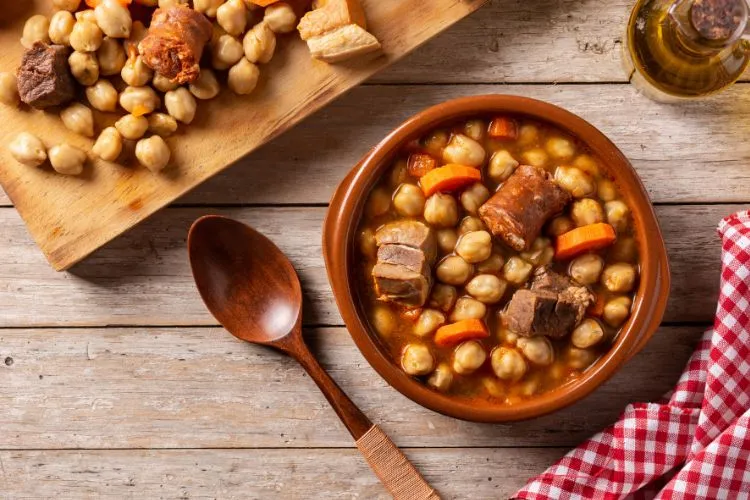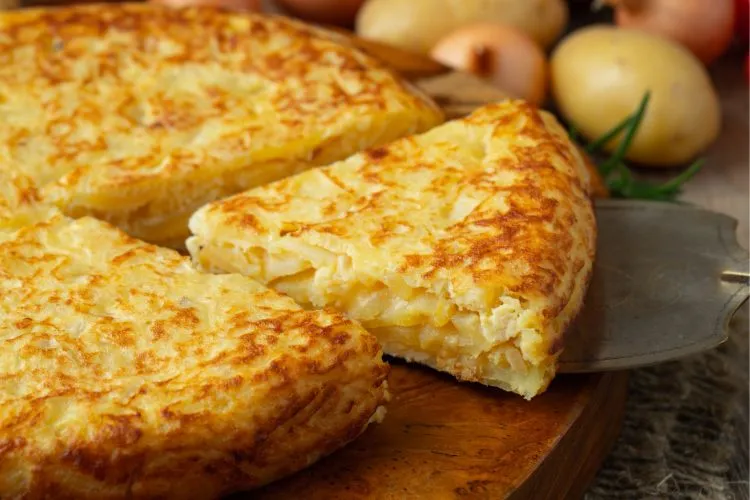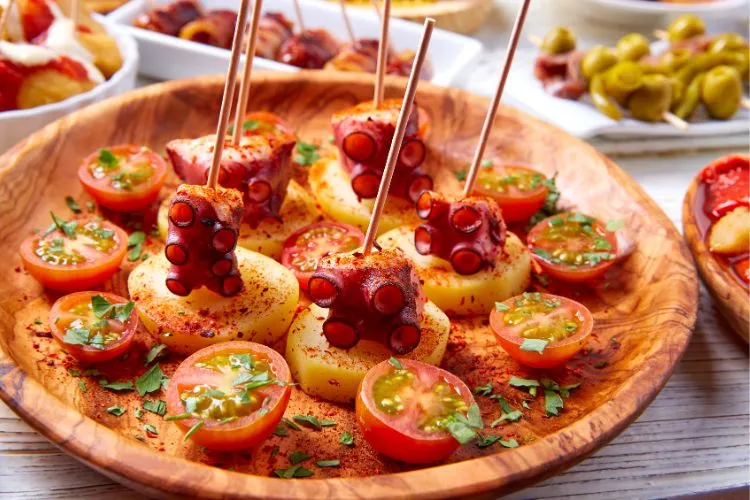12 de February, 2024

Spanish Food: Two words that evoke a journey through delicious dishes, award-winning restaurants, and a balanced diet. Spain has been recognized as the nation with the healthiest food in the world! What makes Spanish Typical Dishes so special? In this article, we will talk a bit about the richness of Spanish flavors, the most famous dishes, and the delicacies you must try as soon as you arrive in the country!
Spain has always stood out in the global gastronomic scene, boasting over 250 Michelin-starred restaurants. Many of these establishments are associated with renowned award-winning chefs, such as Spaniards Dabiz Muñoz and Albert Adrià, who claimed the top two positions in “The Best Chef Awards” in 2023. Additionally, Spain consistently ranks among specialized sites like Taste Atlas. In summary, the country is a true paradise for connoisseurs of haute cuisine.
Comprising various regions, each presenting its own culinary specialties, Spain is recognized for its rich diversity of flavors, use of fresh ingredients, and the application of traditional cooking techniques. Iconic dishes such as paella, gazpacho, tapas, churros, and the famous jamón (ham) are internationally renowned, significantly contributing to the country’s reputation. Moreover, the emphasis on the quality of ingredients, including olive oil, fresh seafood, cured hams, and exceptional wines, plays a crucial role in the excellence of Spanish gastronomy.
Realizing your goal of living in Europe or obtaining European citizenship can be simpler than you think. We offer personalized support to make the immigration process more accessible and uncomplicated.
Spain has been recognized as the healthiest country in the world by the Bloomberg Healthiest Country Index. The index assesses up to 169 nations based on various indicators and studies from the UN, World Bank, and World Health Organization. This ranking is largely attributed to the Spanish lifestyle, centered around the Mediterranean diet, known for bringing overall health benefits. It reduces the risk of cardiovascular diseases, cancer, diabetes, and degenerative diseases. It also aids in weight loss, controls blood sugar, and lowers the risk of diabetes.
The Mediterranean diet in Spain is a rich gastronomic experience, highlighting diverse and local recipes to enjoy delicious and, above all, healthy food. Essential ingredients include the famous olive oil, known as “liquid gold,” vegetables, fruits, nuts, fish, and typical dishes like fresh salads in summer, hearty stews in winter, and the iconic paella, among other healthy options.
Read also: 10 Cheapest Cities in Spain
The culinary diversity of Spain reflects its rich history, marked by influences from Celts, Phoenicians, Greeks, Romans, Arabs, Jews, and Christians. However, the period of the Reconquista, marked by the imposition of Christianity, had a significant impact on food. The Inquisition, established in 1480, played a crucial role in shaping Spanish gastronomy. The prohibition of certain foods associated with Jewish and Muslim traditions resulted in dietary changes.
For example, pork became prominent, encouraged by the Church as a way to check religious conformity. Coriander, an herb widely used by Muslims, was persecuted by the Inquisition, leading to the dominance of parsley in cuisine. Even the consumption of wine was monitored, serving as an indicator of people’s faith.
Furthermore, the periods of fasting and prayer imposed by the Church influenced traditional Spanish dishes, such as Gazpacho and Paella, which became essential during these periods of religious abstinence.
Paella is a traditional dish of Spanish cuisine, specifically from the Valencia region. Its origin dates back to the 15th and 16th centuries. During that time, peasants went to work in the fields carrying only rice, olive oil, and salt. They used a round, shallow pan with two handles, called “Paella,” for cooking.
The ingredients of Paella vary, but the traditional recipe includes rice, saffron, olive oil, and a variety of meats and vegetables. Meat can be chicken, rabbit, or duck, and vegetables include green beans, tomatoes, and sometimes bell peppers. Additionally, Paella can include seafood such as shrimp, squid, clams, mussels, prawns, and octopus.
Paella is a festive dish that Spaniards savor on significant occasions such as weddings, birthdays, baptisms, religious holidays, and weekends.

Cocido Madrileño is a classic dish in Spanish cuisine, originating from Madrid, with its origin uncertain, possibly deriving from the Manchegan olla podrida or the Jewish adafina stew.
The ingredients of Cocido Madrileño vary, but the traditional recipe includes chickpeas, various vegetables, and meats. Meats can be chicken, pork, or beef, and vegetables include cabbage, carrot, turnip, green beans, chard, cardoon, and potatoes.
Additionally, Cocido Madrileño can include sausages such as chorizo and blood sausage. This calorie-rich dish is enjoyed in the cold winter months, served in three parts: soup, chickpeas with vegetables and potatoes, and various meats.

A traditional cold soup from the Andalusia, Extremadura, and Castilla-La Mancha regions. It is composed of tomatoes, garlic, cucumber, olive oil, and bread. Its original recipe did not include tomatoes, one of the most iconic ingredients of the modern recipe. It consisted of bread soaked in water, olive oil, and vinegar, sometimes adding garlic or almonds. The best Gazpachos in Spain are made in the cities of the southern region of the country.

This delicious omelet is made with simple ingredients, highlighting the combination of eggs, potatoes, and onions. The basic recipe consists of thinly sliced potatoes and onions cooked in olive oil, mixed with beaten eggs, and seasoned with salt.
The preparation of the Spanish omelet involves frying the potatoes and onions until soft, then mixing them with the beaten eggs. The mixture is poured into a frying pan and cooked on both sides until it acquires a firm yet juicy consistency inside.

Pulpo a la Gallega is a typical dish from the Galicia region in northwest Spain. The base of the dish is octopus, which is cooked until tender and then sliced. In addition to octopus, the main ingredients include potatoes, paprika, and olive oil.
The origin of tapas has several associated stories, but one of the most common dates back to the 13th or 14th century. It is said that during the reign of Alfonso X, also known as Alfonso the Wise, in Castile, Spain, a law was enacted to ensure that taverns served food with alcoholic drinks to avoid the effects of alcohol on an empty stomach.
To facilitate compliance with this law, food portions were placed over glasses or cups, acting as a “lid” (tapa in Spanish) to protect the drink. This eventually evolved into the widespread practice of serving small food portions along with drinks.
Tapas can encompass a wide variety of foods, from nuts and chestnuts to ham, squid, cheeses, pâtés, among others.
The tapas culture also involves the social aspect, encouraging people to share small portions while enjoying conversations and company. In many places, especially in southern Spain, it is common for tapas to be offered for free when ordering a drink, a tradition known as “free tapa” or “complimentary tapa.”
Calamares a La Romana is a very common and appreciated dish in Spanish cuisine. This dish consists of breaded and fried squid rings. Many people like to serve Calamares a La Romana with aioli, mayonnaise, and a few drops of lemon juice. They are the protagonists of the most typical and famous sandwich in Madrid and many other places, the bocadillo de calamares.
Jamón Serrano, the main product of Spain, originated from the need to preserve food. Pigs were brought by the Phoenicians in 1100 B.C., and it was then that, using the salting technique to preserve food, this delicious food was created and popularized throughout Europe by the Romans. Today, Spanish ham is the most famous in the world and cannot be left out of the menu for those visiting the country.
Read also: 7 Dishes from Lusitanian Cuisine You Need to Know
Spanish cuisine goes beyond being a mere palate experience; it is a living testimony of history, traditions, and the passion that Spaniards invest in each dish. When savoring a dish of Calamares a La Romana in Madrid or enjoying an authentic Jamón Serrano, we immerse ourselves not only in a feast for the senses but in a vibrant celebration of the richness and diversity that make Spain an unparalleled culinary destination.
For those who dream of making Spain not only a culinary destination but a home, there is an open door to live among these extraordinary flavors. If you do not have Spanish citizenship, discovering the ideal visa for your profile can be the key to enjoying life in Spanish lands. Explore our special articles on visas for passive income holders (such as retirees) and visas for those engaged in remote work (digital nomads). Atlantic Bridge is ready to guide you on this journey, making the dream of living in Spain a reality. Click here to schedule a consultation with one of our experts. Until the next culinary adventure and beyond, where the flavors of Spain can become an indelible part of your everyday life! ¡Hasta la próxima aventura culinária e além, onde os sabores da Espanha podem se tornar uma parte indelével do seu cotidiano!
Author:
Silvia Resende